1:10 PM | Colder-than-normal pattern to set up in eastern two-thirds of nation during the second half of April
Paul Dorian
[Today's 500 millibar pattern, map courtesy Penn State eWall, NOAA]
Discussion
Overview
So far the month of April has been warmer-than-normal in DC (+3.5°), Philly (+1.3°) and at Central Park (+1.4°) in New York City, but the overall weather pattern is about to undergo a significant change in the eastern two-thirds of the nation as we progress through the second half of April. In fact, in many ways, the upcoming weather pattern in the upper atmosphere will resemble the one that endured throughout much of the winter season. The threat of snow will even make a return to the Northeast US as we progress through the latter stages of April - at least in some of the higher elevation interior locations.
[Next Wednesday's forecasted 500 millibar pattern, map courtesy Penn State eWall, NOAA]
500 millibar pattern reversal
Currently, there is strong high pressure ridging across the eastern US (top, orange region) and a deep trough of low pressure in the interior western US (top, blue region). As a result, the eastern US is currently enjoying rather mild conditions whereas snow is falling in the central Rockies including in the city of Denver and several feet of the white stuff is possible just to the west of Denver during the next couple of days. All of this is about to change.
According to the latest GFS Ensemble computer model forecast, the ridge in the eastern US will be replaced by deep a low pressure trough (above, blue region) by the middle of next week and a strong high pressure ridge will form across western Canada (above, orange region). This type of 500 millibar pattern existed during much of the winter season and it promotes the transport of colder-than-normal air from Canada into the US. During this transitional period in the overall upper atmosphere pattern, there is likely to be a significant rain event in the Mid-Atlantic region at the beginning of next week and then colder air is destined to follow later in the week.
[North Atlantic Oscillation index (current and past values in black, forecasted index values in red), map courtesy NOAA]
North Atlantic Oscillation index
In addition to the GFS Ensemble forecast, there is corroborating evidence that colder-than-normal weather is coming to the eastern US. An index known as the North Atlantic Oscillation (NAO) is forecasted to flip in signs from positive-to-negative as we progress through the latter stages of April. The current value of the NAO index (above, in black) is clearly in positive territory, but it is forecasted to drop sharply during the next week or so (above, in red). A negative NAO index value this time of year generally supports the idea that colder–than-normal air can be transported from Canada into the central and eastern US. The latest 2-meter temperature anomaly forecast (below) by the GFS computer forecast model for the 5-day period of April 26 to May 1st shows the widespread extent of the coming colder-than-normal weather pattern.
[00Z GFS 2-meter temperature anomaly forecast map for the 5-day period of April 26 - May 01, map courtesy Weather Bell Analytics]




 [12Z GFS 10-day forecast map for 500 millibar height anomalies (blues=low pressure trough, oranges=high pressure ridge); map courtesy "tropicaltidbits.com", NOAA]
[12Z GFS 10-day forecast map for 500 millibar height anomalies (blues=low pressure trough, oranges=high pressure ridge); map courtesy "tropicaltidbits.com", NOAA] [12Z GFS 14-day forecast map for 2-meter temperature anomalies (blues=colder-than-normal, oranges=warmer-than-normal); map courtesy "tropicaltidbits.com", NOAA]
[12Z GFS 14-day forecast map for 2-meter temperature anomalies (blues=colder-than-normal, oranges=warmer-than-normal); map courtesy "tropicaltidbits.com", NOAA]
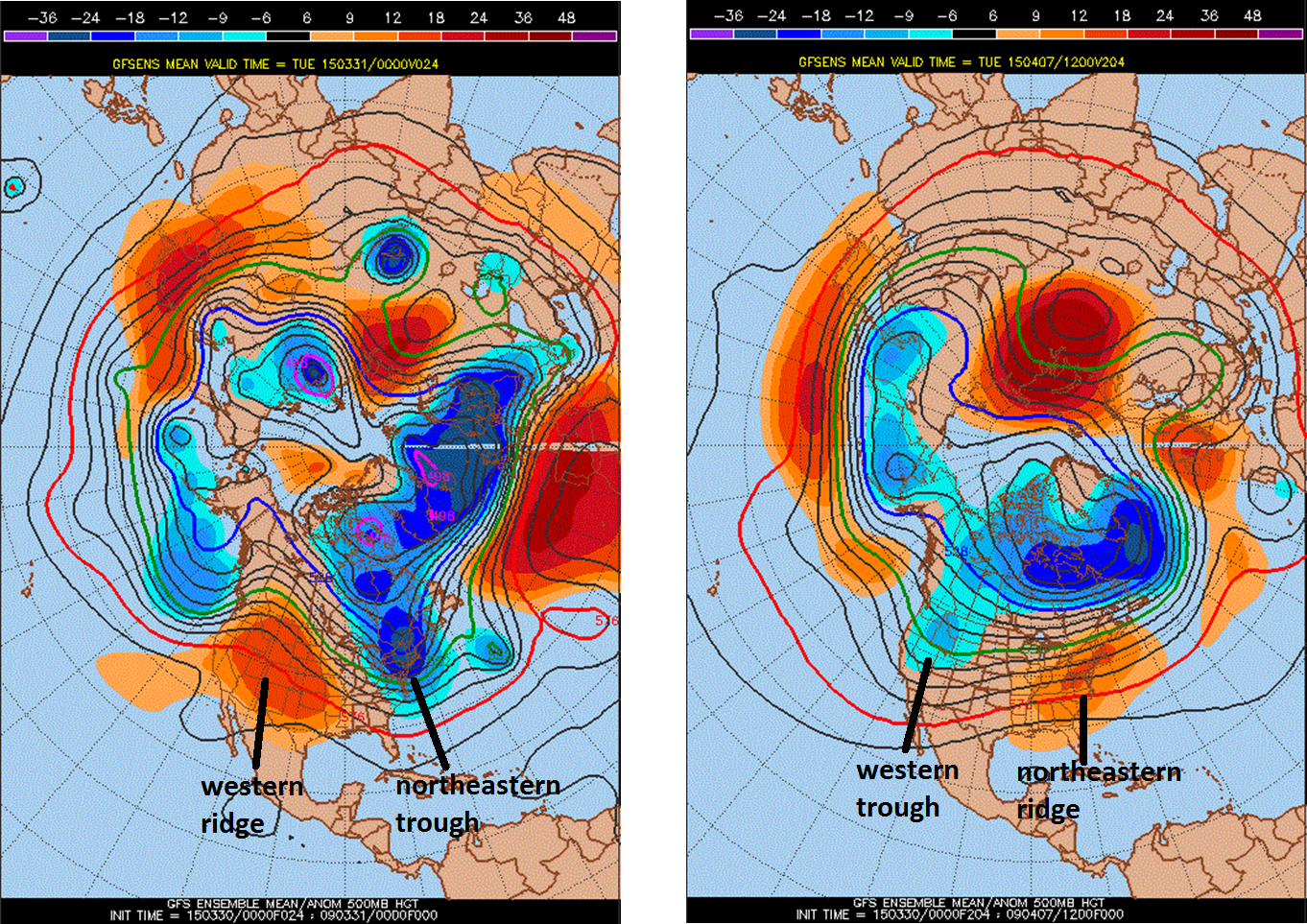 [00Z GFS Ensemble run forecast maps of 500 millibar height anomalies for tomorrow (left) and April 7th (right); map courtesy Penn State e-Wall, NOAA]
[00Z GFS Ensemble run forecast maps of 500 millibar height anomalies for tomorrow (left) and April 7th (right); map courtesy Penn State e-Wall, NOAA] [00Z Canadian model forecast map of 500 millibar height anomalies averaged out for the 7-10 day time period ending on April 7th; map courtesy Penn State e-Wall]
[00Z Canadian model forecast map of 500 millibar height anomalies averaged out for the 7-10 day time period ending on April 7th; map courtesy Penn State e-Wall] [Tornado season is off to an historically low start through the first three months of the year; courtesy NOAA]
[Tornado season is off to an historically low start through the first three months of the year; courtesy NOAA]




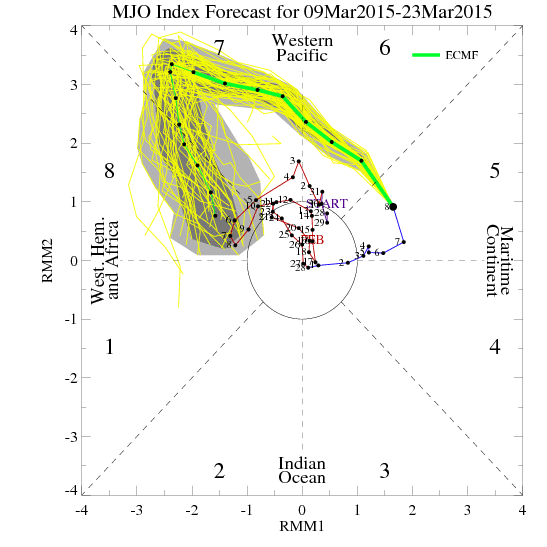 [European model forecast of the MJO index through March 23rd; courtesy NOAA]
[European model forecast of the MJO index through March 23rd; courtesy NOAA]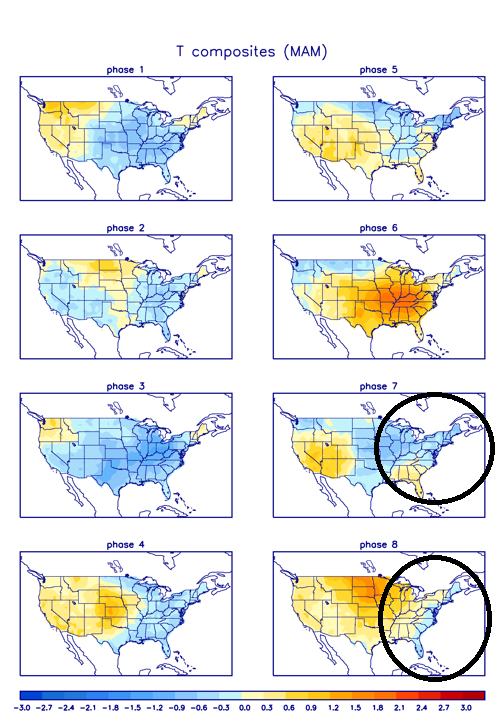 [US temperature anomalies for different phases of the MJO index during the period of March/April/May; courtesy NOAA]
[US temperature anomalies for different phases of the MJO index during the period of March/April/May; courtesy NOAA]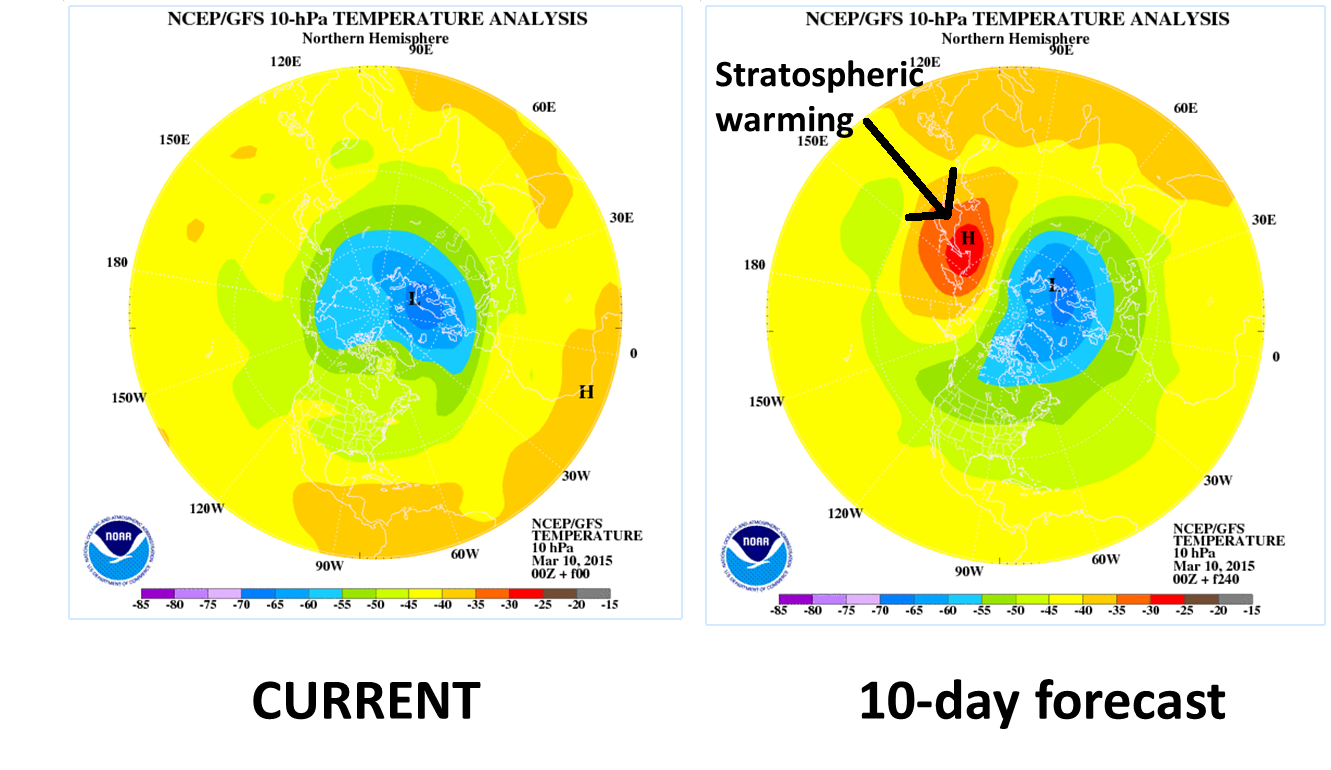 [Temperature analysis at 10 millibars (stratosphere), current and 10-day forecast; courtesy NOAA]
[Temperature analysis at 10 millibars (stratosphere), current and 10-day forecast; courtesy NOAA] [06Z GFS Ensemble 500 mb height anomaly forecast map for March 20th; map courtesy "tropicaltidbits.com", NOAA]
[06Z GFS Ensemble 500 mb height anomaly forecast map for March 20th; map courtesy "tropicaltidbits.com", NOAA] [Observed (black) and forecast (red) of the Arctic Oscillation index; courtesy NOAA]
[Observed (black) and forecast (red) of the Arctic Oscillation index; courtesy NOAA] [NOAA CFSv2 45-day temperature anomaly forecast; map courtesy Weather Bell Analytics at weatherbell.com, NOAA]
[NOAA CFSv2 45-day temperature anomaly forecast; map courtesy Weather Bell Analytics at weatherbell.com, NOAA] [06Z GFS 500 millibar height anomaly forecast for March 6th; map courtesy "tropicaltidbits.com, NOAA]
[06Z GFS 500 millibar height anomaly forecast for March 6th; map courtesy "tropicaltidbits.com, NOAA]


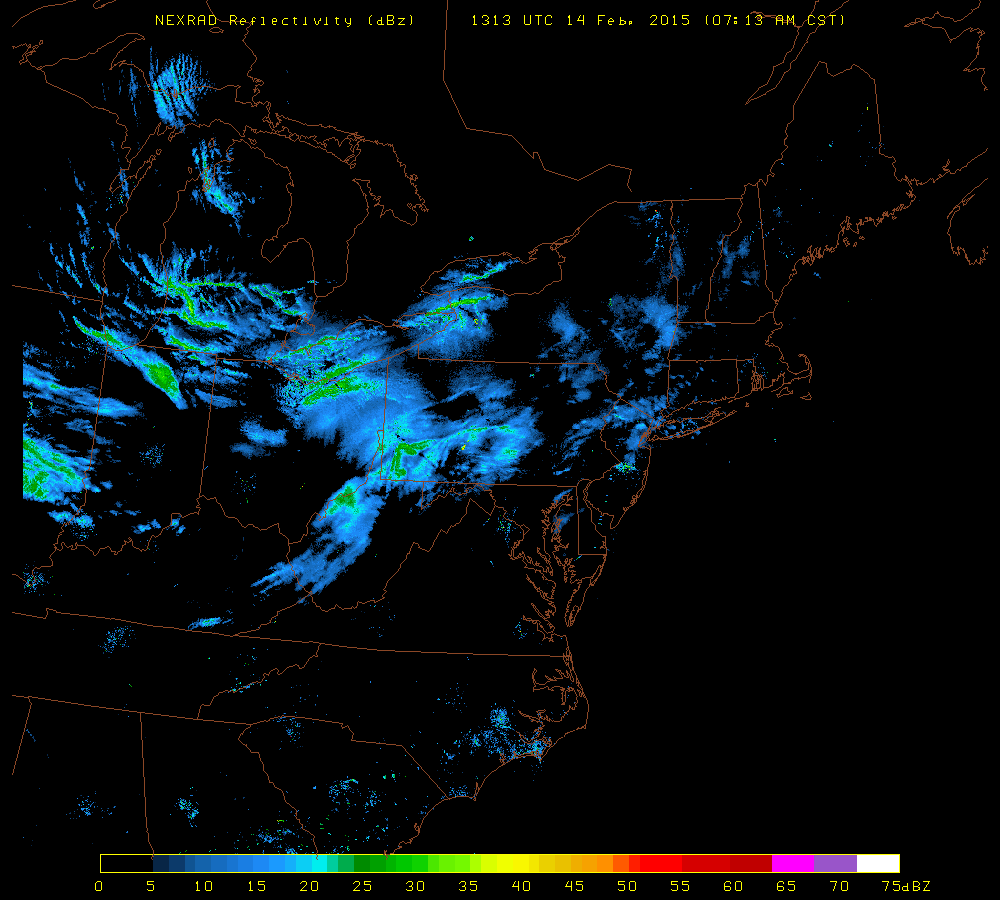 [Early morning NEXRAD radar image with snow over the Great Lakes/Ohio Valley and headed our way; image courtesy University of Wisconsin]
[Early morning NEXRAD radar image with snow over the Great Lakes/Ohio Valley and headed our way; image courtesy University of Wisconsin]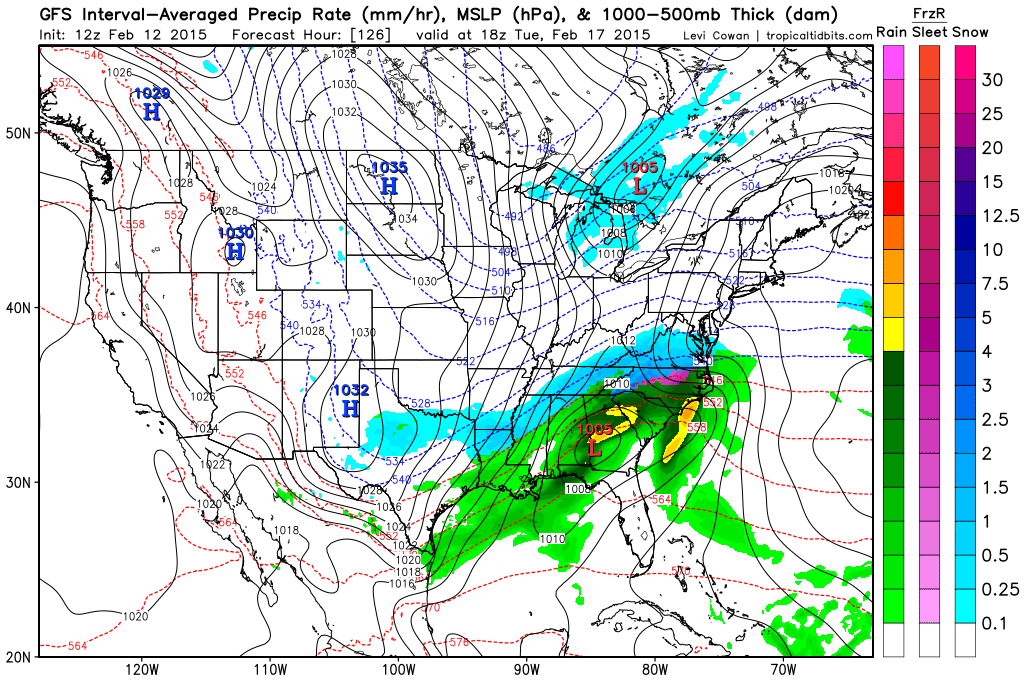 [12Z GFS forecast map for next Tuesday early afternoon (blue=snow); map courtesy "tropicaltidbits.com", NOAA]
[12Z GFS forecast map for next Tuesday early afternoon (blue=snow); map courtesy "tropicaltidbits.com", NOAA]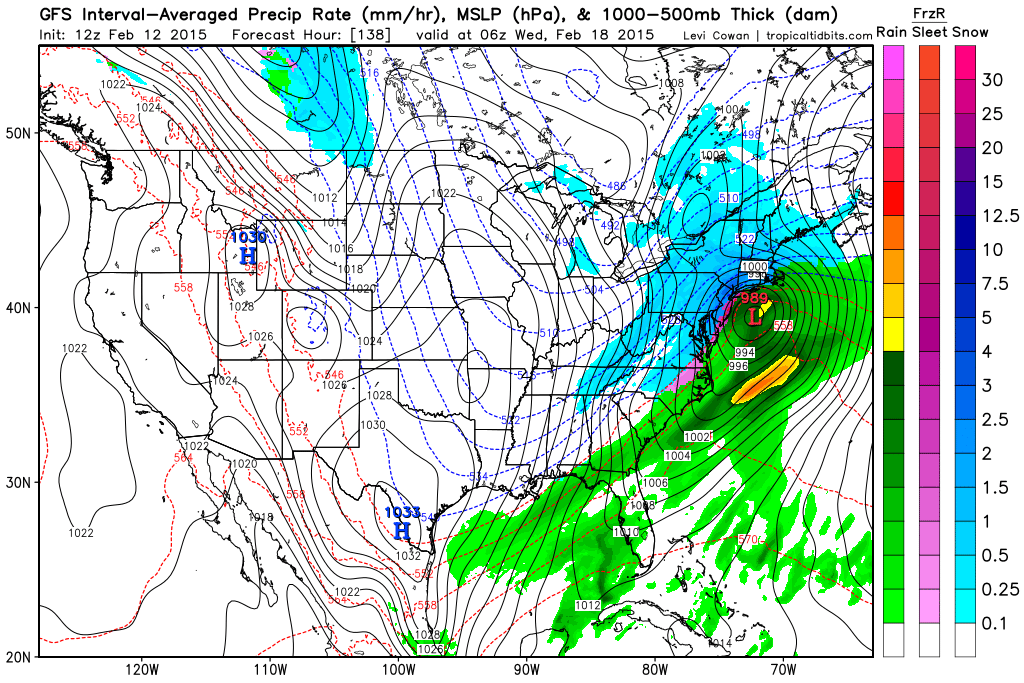 [12Z GFS forecast map for late Tuesday night (blue=snow); map courtesy "tropicaltidbits.com", NOAA]
[12Z GFS forecast map for late Tuesday night (blue=snow); map courtesy "tropicaltidbits.com", NOAA]